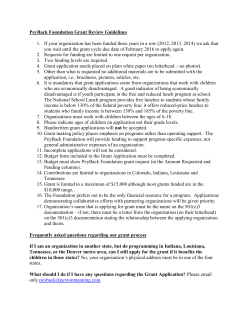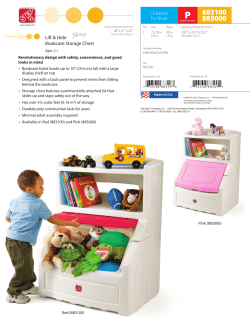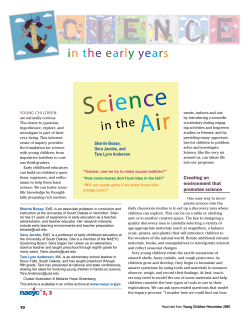
Teaching Strategies GOLD Objectives for Development & Learning: Through
Assessment Alignment of Teaching Strategies GOLD® Objectives for Development & Learning: Birth Through Kindergarten with Montana Early Learning Guidelines ® Alignment of the Teaching Strategies GOLD Objectives for Development & Learning: Birth Through Kindergarten With Montana Early Learning Guidelines ® This document aligns the content in the Montana Early Learning Guidelines with the objectives, dimensions, and indicators of the Teaching Strategies GOLD assessment system. References Montana Department of Public Health and Human Services/Early Childhood Services Bureau and Montana Early Childhood Project. (2004). Montana early learning guidelines Bozeman, MT: Author. Retrieved April 24, 2013 from http://www.mtecp.org/pdfs/ELG%20Final%20Text%20.pdf ® Heroman, C., Burts, D. C., Berke, K., & Bickart, T. S. (2010). Teaching Strategies GOLD objectives for development & learning: Birth through kindergarten. Bethesda, MD: Teaching Strategies, LLC. Alignment © 2013 Teaching Strategies, LLC, www.TeachingStrategies.com 1 Montana Early Learning Guidelines Teaching Strategies GOLD® Objectives, Dimensions, and Indicators Language and Literacy Ages three to five 1:. Children enter into the exchange of information around what is seen, heard, and experienced. They begin to acquire the concepts and language that contribute to learning to communicate and, eventually, to read. 9. Uses language to express thoughts and needs 9a. Uses an expanding expressive vocabulary 5 emerging to 6. Describes and tells the use of many familiar items 2:. Children learn when they talk out loud. Children use words to help adults and others to understand their needs, ask questions, express feelings and solve problems. 9. Uses language to express thoughts and needs 9b. Speaks clearly 6. Is understood by most people; may mispronounce new, long, or unusual words 3:. Children become aware of the sounds of letters and combinations of letters that make up words. They begin to manipulate syllables and sounds of speech. 15. Demonstrates phonological awareness 15c. Notices and discriminates smaller and smaller units of sound 4. Hears and shows awareness of separate syllables in words 4:. Children acquire an understanding that print carries a message through 17. Demonstrates knowledge of print and its uses symbols and words. Children learn to make the connection between sounds and 17b. Uses print concepts letters (the alphabetic principle). 6. Shows awareness of various features of print: letters, words, spaces, upper- and lowercase letters, some punctuation 5:. Children acquire the ability to write through a sequence of stages, although 19. Demonstrates emergent writing skills individual children will become writers at different rates. These stages are: 19b. Writes to convey meaning writing using scribble-like markings; writing using individual letter-like marks 4. Letter strings or mock letters; writing using recognizable, random letter strings; writing using semi-phonetic spelling; and writing using phonetic spelling. Mathematics Ages three to five 1:. Children develop the ability to think and work with numbers easily, to understand their uses, and describe their relationships. Children learn the meaning of numbers in their everyday experiences (e.g., home, early childhood settings, community and nature). 20. Uses number concepts and operations 20b. Quantifies 6. Makes sets of 6–10 objects and then describes the parts; identifies which part has more, less, or the same (equal); counts all or counts on to find out how many 2:. Children apply mathematical skills through counting, sorting, and comparing 20. Uses number concepts and operations objects. Children describe their thinking and observations in everyday 20a. Counts situations. 4. Verbally counts to 10; counts up to five objects accurately, using one number name for each object Alignment © 2013 Teaching Strategies, LLC, www.TeachingStrategies.com 2 Montana Early Learning Guidelines 3:. Children learn to identify and describe patterns using mathematical language. They develop the ability to reproduce patterns they see and to create new ones. Teaching Strategies GOLD® Objectives, Dimensions, and Indicators 23. Demonstrates knowledge of patterns 6. Extends and creates simple repeating patterns 4:. Children build the foundation for recognizing and describing shapes by 21. Explores and describes spatial relationships and shapes manipulating, playing with, tracing, and making common shapes using real 21a. Understands spatial relationships objects in a variety of activities. Children learn spatial reasoning and directional 6. Uses and responds appropriately to positional words indicating words as they become aware of their bodies and personal space within their location, direction, and distance physical environment. 5:. Children begin to use measurement instruments to explore and discover measurement relationships. They apply the characteristics of length, quantity, volume, distance, weight, area, and time to real life situations in order to construct concepts of measurement. 22. Compares and measures 6. Uses multiples of the same unit to measure; uses numbers to compare; knows the purpose of standard measuring tools 6:. Children build a foundation for solving problems by formulating questions and possible solutions individually and with others based on their observations and experiences. 20. Uses number concepts and operations 20b. Quantifies 6. Makes sets of 6–10 objects and then describes the parts; identifies which part has more, less, or the same (equal); counts all or counts on to find out how many Physical Development and Health Ages three to five 4. Demonstrates traveling skills 1:. Young children observe, practice, demonstrate, and compare fundamental movements while learning to control their bodies in relation to other individuals 6. Moves purposefully from place to place with control and independent objects in their environment. 2:. Young children begin to develop movement and sensory vocabulary and use 21. Explores and describes spatial relationships and shapes it accurately. Young children apply movement concepts to motor skills by 21a. Understands spatial relationships responding appropriately to: direction (front/back, side/side, left/right), personal 6. Uses and responds appropriately to positional words indicating and general space, effort and force (hard/soft), speed and flow (fast/slow) and location, direction, and distance sensory experiences (rough/smooth, hot/cold). 3:. Young children seek out and participate in challenging physical activities, including sensory experiences that support their growth in self-expression and social interactions with others. Alignment © 2013 Teaching Strategies, LLC, www.TeachingStrategies.com 4. Demonstrates traveling skills 6. Moves purposefully from place to place with control 3 Montana Early Learning Guidelines Teaching Strategies GOLD® Objectives, Dimensions, and Indicators 4:. While participating in physical activities, young children develop an awareness of health and safety practices that support the growth of a healthy lifestyle. 1. Regulates own emotions and behaviors 1b. Follows limits and expectations 6. Manages classroom rules, routines, and transitions with occasional reminders 5:. Young children begin to demonstrate an understanding and respect for differences among people during physical activities. 30. Shows basic understanding of people and how they live Science Ages three to five 1:. Children will learn to ask questions about the world around them, the first step in the scientific method, based on observations, experiences, and interests. 24. Uses scientific inquiry skills 2:. Children will learn to predict answers and form hypotheses, the second step in the scientific method. 24. Uses scientific inquiry skills 3:. Children will learn to conduct experiments in order to test their predictions, the third step in the scientific method. 24. Uses scientific inquiry skills 4:. Children will learn to observe and record findings, the fourth step in the scientific method. 24. Uses scientific inquiry skills 5:. Children will learn to form conclusions, the fifth step in the scientific method. 24. Uses scientific inquiry skills 6:. Children will learn to communicate final results, the sixth step in the scientific method. 24. Uses scientific inquiry skills Social-Emotional Development Ages three to five 1:. Children begin to identify who they are as a person (such as likes, dislikes, interests, strengths) and develop competence and confidence in their own unique abilities. They grow into themselves, differentiating themselves from parents and others, developing and beginning to recognize their areas of strength and skill, and applying their emerging esteem alone and in groups. 29. Demonstrates knowledge about self 2:. Children learn to identify and express their feelings in non-hurtful ways, recognize the impact their behavior has on others, and practice self-control. 1. Regulates own emotions and behaviors 1a. Manages feelings 6. Is able to look at a situation differently or delay gratification Alignment © 2013 Teaching Strategies, LLC, www.TeachingStrategies.com 4 Montana Early Learning Guidelines 3:. Children learn to feel secure as they develop relationships of trust with adults and other children in their expanding world beyond the family. They begin to recognize social cues and become sensitive to others’ feelings. Teaching Strategies GOLD® Objectives, Dimensions, and Indicators 2. Establishes and sustains positive relationships 2a. Forms relationships with adults 5 emerging to 6. Manages separations without distress and engages with trusted adults 4:. Children follow routines with increasing independence and handle variations 1. Regulates own emotions and behaviors without discomfort. They make their preferences known in increasingly mature 1b. Follows limits and expectations ways and respond to adult guidance appropriately. Children begin to make 6. Manages classroom rules, routines, and transitions with occasional friends and build relationships with both peers and adults. reminders Social Studies Ages three to five 1:. Young children begin to understand the concept of time, including past, present, and future. They are able to recognize recurring experiences that are part of the daily routine. 31. Explores change related to familiar people or places 2:. Young children begin to follow rules and set personal boundaries for their behavior, as well as understand why rules are created. When presented with a set of alternatives, children are able to make choices for their own lives. 1. Regulates own emotions and behaviors 1b. Follows limits and expectations 6. Manages classroom rules, routines, and transitions with occasional reminders 3:. Through exploration, young children learn that every place has its own unique characteristics. As they become aware of their bodies in space, they develop an understanding of how they are affected by, and the effect they have upon, the world around them. 32. Demonstrates simple geographic knowledge 4:. As young children explore the environment, they become aware of how 27. Demonstrates knowledge of Earth’s environment people and the earth interact. By 4 and 5 years of age, children begin to understand how people use natural resources and change the earth for their own benefit. They develop an awareness of how to care for their physical environment and why it is important. 5:. Young children begin to notice and react to similarities and differences (such 30. Shows basic understanding of people and how they live as appearance, gender, and behavior) between themselves and others. With appropriate guidance, they are able to experience empathy for other people. 6:. Young children began to understand the basic principles of community function, including work roles and the importance of money for purchasing. They see how their family interacts with the community to receive needed goods and services. Alignment © 2013 Teaching Strategies, LLC, www.TeachingStrategies.com 30. Shows basic understanding of people and how they live 5 Montana Early Learning Guidelines Teaching Strategies GOLD® Objectives, Dimensions, and Indicators Creative Arts Ages three to five 1:. Children express personal interests, ideas, and feelings through art and begin 33. Explores the visual arts to share opinions about artwork and artistic experiences. 2:. Children use symbols, elements such as shape, line, color, and texture, and principles such as repetition in art experiences. 33. Explores the visual arts 3:. Children use different art media and materials in a variety of ways for creative expression, exploration, and sensory experience. 33. Explores the visual arts 4:. Children show enjoyment of music through facial expressions, vocalizations, 34. Explores musical concepts and expression and various movements. 5:. Children produce vocal/instrumental music and rhythmic movements spontaneously and in imitation. 34. Explores musical concepts and expression 6:. Children begin to differentiate variations in tempo, dynamics, and types of sounds made by different classes of instruments (percussion, wind, and string). 34. Explores musical concepts and expression 7:. Children show appreciation and awareness of drama through observation and imitation, and by participating in simple dramatic plots, assuming roles related to their life experiences. Young children enjoy telling stories through action, dialogue or both. 36. Explores drama through actions and language 8:. Children create and direct complex scenarios based on individual and group experiences. Children create situations, arrange environments to bring their drama to life, assume roles, direct others and accept direction from others. 36. Explores drama through actions and language 9:. Children role play stories in books, poems and simple imaginary themes using elements of drama including character, place, theme or idea. 36. Explores drama through actions and language Alignment © 2013 Teaching Strategies, LLC, www.TeachingStrategies.com 6
© Copyright 2025





















